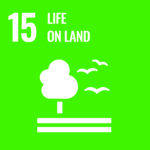Material required
- Line level,
- Digging instruments,
- Stones of mixed sizes (for stone-faced bunds).
- If combined with revegetation: suitable native grass and legumes, suitable tree seedlings of at least 30 cm in height.
Steps of implementation
- Looking at a field with contour bunds from above consists of a sequence of parallel earth bunds running along contour lines. Their spacing depends on the slope of the hill and should decrease in size with an increasing slope: the steeper the slope, the closer the contour bunds will be. It is recommended to grow vegetation along the bunds to improve their stability.
- Contour bunds are frequently used in the valley bottom since they are often slightly concave. The bunds will be built with a parabolic shape to allow water to spread to the sides.
- The soil excavated from the adjacent ditch is relocated upslope and will form the bunds. A bund‘s height is usually around 20-40 cm, but this can vary depending on the slope. Their base should be at least 75 cm wide. There are also small earth ridges perpendicular to the bunds, and located on the upslope side, that divide the system into microcatchments. These cross-ties shouldn’t be less than 2 m long and are formed by the soil obtained from the excavation of the infiltration pits. The layout of this intervention also implies infiltration pits (usually 80x80x40 cm) that are excavated at the intersection between bunds and ties.
- Contour bunds might also include the presence of trees. Planting sites are expected to be between the infiltration pit and the cross-tie. It is recommended to plant seedlings that are at least 30 cm high, and the best planting period is right after the first runoff has been collected. If needed, it is also possible to add manure or compost to the planting pit to increase fertility and its water-holding capacity.
- Finally, where needed, in the layout there might also be a diversion ditch, to protect the entire system from flooding during heavy rainfalls. Diversion ditches are small excavations for diverting overland flow away from exposed slopes, redirecting water to where it can be safely discharged (such as a sediment basin)
Disclaimer: Like Negarim, some maintenance interventions might be required to repair damaged bunds early in the first season. Such damages are frequently caused by animals invading the areas or strong rainfalls.
A good explanation of how to build contour bunds following slope lines can be found here.
This intervention contributes to:



Estimated costs & benefits of intervention
| Establishment cost |
about US $30 per ha |
| Labor time |
120 person-days for one hectare of contour bunding |
| Maintenance cost |
If properly implemented, maintenance costs are 5%-10% of implementation costs. |
| Benefits |
Income is boosted by about 20% |
| Products |
Paddy, pigeon pea, groundnut, sorghum, cotton, black beans, wheat, gram, vegetables |
Source: Basesd on case study in Bharuch District, India (1994).
1. Contour bunding project in Mali
Description
Contour bunding in Mali helps retain moisture and nutrients while preventing soil erosion and bringing a 20% increase in income to local populations. The technique used facilitates perennial grasses, which are arranged in ridges that farmers usually use for crop production. The technique helps the increase in crop yield, without expanding the farmlands. The project was conveyed in Kani, Mali with the support of the International Crops Research Institute for the Semi-Arid Tropics (ICRISAT). One of the major implications of the study is the local involvement and building up of the farmers' community in which members are willing to incorporate the contour bunding technique and share knowledge. Overall, the case of Mali shows how crucial Soil and Water conservation practices are to ensure curbing land degradation and increasing land productivity.
2. Contour bunding and stone-faced soil bunds in Ethiopia
Description
This intervention involves creating an embankment of soil, stones, or a combination of both, along the contour lines of a slope. These bunds, typically 1-1.2 meters wide and 0.6-0.7 meters high, are stabilized using vegetative measures such as grass and fodder trees. Suitable for slopes greater than 3%, the bunds slow down runoff, reduce soil erosion, retain water for infiltration, and aid in groundwater recharge. Establishing these bunds involves community discussions to agree on layout, spacing, and management before implementation. The technology is effective in areas with moderately deep soil and available stones. This practice has been successfully applied in Ethiopia, specifically in the Southern Nations, Nationalities, and Peoples' Region (SNNPR), within the Hadiya Zone and Lemo Woreda. Covering an area of 173 km², the intervention has led to reduced runoff and soil erosion, increased land productivity, and a positive shift in community attitudes towards soil and water conservation (SWC) technologies.


